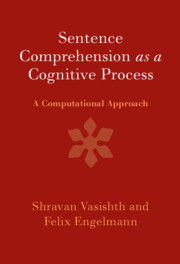Book contents
- Frontmatter
- Contents
- List of Figures
- List of Tables
- Foreword by Richard L. Lewis
- Preface
- Acknowledgements
- 1 Introduction
- 2 Dependencies in Sentence Comprehension
- 3 The Core ACT-R-Based Model of Retrieval Processes
- 4 An Extension of the Core Model: Modelling Prominence and Multi-associative Cues
- 5 An Extension of the Core Model: Modelling the Interaction of Eye-Movement Control and Parsing
- 6 Reanalysis and Underspecification in Sentence Comprehension: Modelling Eye Movements
- 7 Competing Accounts of Interference in Sentence Processing
- 8 Modelling Sentence Comprehension Deficits in Aphasia
- 9 Future Directions
- Bibliography
- Index
- References
Bibliography
Published online by Cambridge University Press: 29 October 2021
- Frontmatter
- Contents
- List of Figures
- List of Tables
- Foreword by Richard L. Lewis
- Preface
- Acknowledgements
- 1 Introduction
- 2 Dependencies in Sentence Comprehension
- 3 The Core ACT-R-Based Model of Retrieval Processes
- 4 An Extension of the Core Model: Modelling Prominence and Multi-associative Cues
- 5 An Extension of the Core Model: Modelling the Interaction of Eye-Movement Control and Parsing
- 6 Reanalysis and Underspecification in Sentence Comprehension: Modelling Eye Movements
- 7 Competing Accounts of Interference in Sentence Processing
- 8 Modelling Sentence Comprehension Deficits in Aphasia
- 9 Future Directions
- Bibliography
- Index
- References
Summary

- Type
- Chapter
- Information
- Sentence Comprehension as a Cognitive ProcessA Computational Approach, pp. 203 - 220Publisher: Cambridge University PressPrint publication year: 2021

